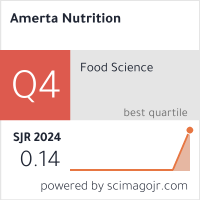Sorghum Flour and Coconut Flour Snack Bars as Functional Foods for Type 2 Diabetes Mellitus
Snack Bar Tepung Sorgum dan Tepung Kelapa sebagai Pangan Fungsional untuk Penderita Diabetes Melitus Tipe 2

Background: People with type 2 diabetes mellitus (T2DM) can control blood sugar levels through adequate fiber consumption. Sorghum flour and coconut flour are non-gluten flours that have high fiber content. Developing functional foods, such as snack bars made from these flours, could help regulate blood glucose levels.
Objectives: This study aimed to examine the effect of the proportion of sorghum flour and coconut flour on the nutritional content, dietary fiber content, and organoleptic properties of snack bars.
Methods: This study used a completely randomized design with 3 formulations (70:30, 50:50, and 30:70 ratios of sorghum to coconut flour) and 2 repetitions. The gravimetric method was used to analyze water content and ash content. The Kjeldahl and Soxhlet extraction methods were employed to analyze the protein and fat content, respectively. Carbohydrate content was determined using by difference method, and fiber content was evaluated using the enzymatic method. ANOVA and the Kruskal-Wallis test were used to see the differences in proximate, fiber, and organoleptic properties, respectively.
Results: The results showed significant differences in ash content (p-value<0.001), protein (p-value=0.002), fat (p-value=0.047), carbohydrates (p-value=0.049), and dietary fiber (p-value<0.001). Taste is one of the hedonic test parameters that has a significant difference (p-value=0.005). The selected snack bar formula was F3 with energy, fat, protein, carbohydrate, and fiber content was 108 kcal, 5.18 g, 4.56 g, 10.85 g, and 10.91 g respectively.
Conclusions: Snack bars made from sorghum and coconut flour are rich in dietary fiber and suitable for consumption by individuals with T2DM.
Magliano, D. J. & Boyko, E. J. IDF Diabetes Atlas 10th Edition Scientific Committee. IDF Diabetes Atlas [Internet]. (International Diabetes Federation, Brussels, 2021).
Kementerian Kesehatan RI. Laporan Nasional Riskesdas 2018. (Kementerian Kesehatan RI, Jakarta, 2018).
Soelistijo, S. Pedoman Pengelolaan dan Pencegahan Diabetes Melitus Tipe 2 Dewasa di Indonesia 2021. (PB PERKENI, Jakarta, 2021).
Lestari, Zulkarnain & Sijid, S. A. Diabetes Melitus: Review Etiologi, Patofisiologi, Gejala, Penyebab, Cara Pemeriksaan, Cara Pengobatan dan Cara Pencegahan. in Prosiding Biologi Achieving the Sustainable Development Goals with Biodiversity in Confronting Climate Change 237–241 (2021). https://doi.org/10.24252/psb.v7i1.24229.
Purwandari, C. A. A., Wirjatmadi, B. & Mahmudiono, T. Faktor Risiko Terjadinya Komplikasi Kronis Diabetes Melitus Tipe 2 pada Pra Lansia. Amerta Nutr. 6, 262–271 (2022). https://doi.org/10.20473/amnt.v6i3.2022.262-271.
Torawoba, O. R., Nelwan, J. E. & Asrifuddi, A. Diabetes Melitus dan Penyakit Jantung Koroner pada Pasien Rawat Jalan Rumah Sakit. Kesmas 10, 87–92 (2021).
Zaddana, C., Almasyhuri, A., Nurmala, S. & Oktaviyanti, T. Snack Bar Berbahan Dasar Ubi Ungu dan Kacang Merah sebagai Alternatif Selingan Penderita Diabetes Mellitus. Amerta Nutr. 5, 260–275 (2021). https://doi.org/10.20473/amnt.v5i3.2021.260-275.
Mulmuliana & Rachmawati. Dampak Konsumsi Pangan Tinggi Kandungan Indeks Glikemik dengan Kejadian Diabetes Melitus tipe-II di Kabupaten Pidie The. SAGO Gizi dan Kesehat. 3, 163–167 (2022). http://dx.doi.org/10.30867/gikes.v3i2.659.
Viswanathan, V. et al. Insights on Medical Nutrition Therapy for Type 2 Diabetes Mellitus: An Indian Perspective. Adv. Ther. 36, 520–547 (2019). https://doi.org/10.1007/S12325-019-0872-8.
Sunarti. Serat Pangan dalam Penanganan Sindrom Metabolik. (Gadjah Mada University Press, Yogyakarta, 2017).
Parmar, P. T., Singh, A. K. & Borad, S. G. Coconut (Cocos nucifera). in Oilseeds: Health Attributes and Food Applications 1–516 (Springer Nature Singapore, Singapura, 2020). https://doi.org/10.1007/978-981-15-4194-0.
Leboe, D. W., Dhuha, N. S., Wahyuddin, M. & Rutami, N. R. The Potential of Sorghum Bicolor L. as a Blood Glucose Lowering Agent : A Review. in The 2nd Alauddin Pharmaceutical Conference and Expo (ALPHA-C) 2020 1–10 (2020). https://doi.org/10.24252/kesehatan.v1i1.18181.
Suarni. Potensi Sorgum sebagai Bahan Pangan Fungsional. IPTEK Tanam. Pangan 7, 58–66 (2012).
Bozbulut, R. & Sanlier, N. Promising Effects of β-glucans on Glyceamic Control in Diabetes. Trends Food Sci. Technol. 83, 159–166 (2019). https://doi.org/10.1016/j.tifs.2018.11.018.
Raghavarao, K. S. M. . S., Raghavendra, S. N. & Rastogi, N. K. Potential of Coconut Dietary Fiber. Indian Coconut J. 2–7 (2008).
Vijayakumar, V. et al. Diet Enriched with Fresh Coconut Decreases Blood Glucose Levels and Body Weight in Normal Adults. J. Complement. Integr. Med. 15, 1–7 (2018). https://doi.org/10.1515/jcim-2017-0097.
Susanto, D. A. & Kristiningrum, E. Pengembangan Standar Nasional Indonesia (SNI) Pangan Fungsional untuk Membantu Mengurangi Resiko Obesitas. J. Stand. 23, 53–64 (2021). http://dx.doi.org/10.31153/js.v21i1.734.
Crisan, R., Rafiony, A., Purba, J. S. R. & Mulyanita. Daya Terima dan Kandungan Gizi Snack Bar Tepung Tempe dan Tepung Pisang Ambon. Pontianak Nutr. J. 5, 191–200 (2022). https://doi.org/10.30602/pnj.v5i1.965.
Billah, M. M., Wiboworini, B. & Prayitnjo, A. Uji Coba Pemberian Snack Bars Berbahan Dasar Tape Ketan Hitam sebagai Sumber Serat terhadap Penurunan Kadar Glukosa Darah Puasa Pasien Diabetes Melitus Tipe 2. J. Penyakit Dalam Indones. 10, 176–182 (2023). https://doi.org/10.7454/jpdi.v10i4.1478.
Desnita, Yusmaita, E., Iswendi & Iryan. Studi Tingkat Preferensi Panelis Terhadap Karakteristik Sensori Selai Kolang Kaling (Arenga Pinnatafruits). J. Ilm. Pengabdi. Kpd. Masy. 5, 75–81 (2021). https://doi.org/10.25077/logista.5.2.75-81.2021.
AOAC. Official Methods of Analysis of the Association of Analytical Chemist. (Virginia USA : Association of Official Analytical Chemist, Inc, Washington D.C., 2005).
Purwasih, R. Analisis Pangan. (POLSUB PRESS, Subang, 2022). https://doi.org/10.17605/OSF.IO/J8V9P.
Listrianah, L., Palembang, P. K., Purba, R. & Manado, P. K. Ilmu Gizi. (Pustaka Aksara, Surabaya, 2023).
USDA. Nutrition values of Snacks, Nutri-Grain Fruit and Nut Bar. Food Data Central https://fdc.nal.usda.gov/fdc-app.html#/food-details/173151/nutrients (2018).
Yudasri, D., Ali, A. & Ayu, D. F. Pemanfaatan Tepung Ampas Tahu dengan Penambahan Pisang Ambon Sale dalam Pembuatan Snack Bars. J. Online Mhs. Fak. Pertan. Univ. Riau 4, 1–15 (2017).
PT. Amerta Indah Otsuka. Produk - Soyjoy. https://www.soyjoy.id/produk/ (2019).
Basuki, E. et al. Buku Kimia Pangan. (Mataram University Press, Mataram, 2019).
Polii, F. F. Pengaruh Substitusi Tepung Kelapa Terhadap Kandungan Gizi dan Sifat Organoleptik Kue Kering. Bul. Palma 18, 91–98 (2017). https://doi.org/10.21082/bp.v18n2.2017.91-98.
Avif, A. N. & TD, A. O. Analisis Sifat Kimia Tepung dan Pati Sorgum dari Varietas Bioguma dan Lokal di Provinsi Nusa Tenggara Timur, Indonesia. Lantanida J. 8, 178–188 (2020). https://doi.org/10.22373/lj.v8i2.8120.
Pusungulena, S. O., Nurali, E. J. N. N. & Assa, J. R. Pengaruh Substitusi Tepung Ampas Kelapa (Cocos Nucifera L.) Terhadap Serat Pangan, Daya Kembang, Karakteristik Kimia dan Tingkat Kesukaan Bolu. J. Teknol. Pertan. 14, 44–56 (2023). https://doi.org/10.35791/jteta.v14i1.50847.
Sarifudin, A., Ekafitri, R., Surahman, D. N. & Putri, S. K. D. F. A. Pengaruh Penambahan Telur pada Kandungan Proksimat Karakteristik Aktivitas Air Bebas (aw) dan Tekstural Snack Bar Berbasis Pisang (Musa paradisiaca). J. Agritech 35, 1–8 (2015). https://doi.org/10.22146/agritech.9413.
Desiliani, Harun, N. & Fitriani, S. Pemanfaatan Tepung Pisang Kepok dan Buah Nangka Kering dalam Pembuatan Snack Bar. J. Teknol. Pangan 13, 1–11 (2019). https://doi.org/10.33005/jtp.v13i1.1503.
Cortes-Herrera, C. et al. Analysis of Minerals in Foods: A Three-year Survey from Costa Rican Market Products. J. Food Res. 12, 9–35 (2022). https://doi.org/10.5539/jfr.v12n1p9.
Pramusita, N., Fitriana, I., Sani, E. Y. & Haslina. Lama Penyimpanan terhadap Kadar Air, Kadar Abu, dan Kadar Serat Kasar Marshmallow Semangka. (Universitas Semarang, 2019).
Watford, M. & Wu, G. Protein. Adv. Nutr. 9, 651–653 (2018). https://doi.org/10.1093/ADVANCES/NMY027
Jiamjariyatam, R., Roskhrua, P. & Attiwittayaporn, S. Effect of Coconut Flour on Biscuit Quality. J. Culin. Sci. Technol. 20, 278–292 (2022). https://doi.org/10.1080/15428052.2021.1978362.
Probosari, E. Pengaruh Protein Diet Terhadap Indeks Glikemik. JNH (Journal Nutr. Heal. 7, 33–39 (2019). https://doi.org/10.1080/15428052.2021.1978362.
Yanagisawa, Y. How Dietary Amino Acids and High Protein Diets Influence Insulin Secretion. Physiol. Rep. 11, 1–14 (2023). https://doi.org/10.14814/phy2.15577.
Ischak, N. I., Salimi, Y. K. & Botutihe, D. N. Biokimia Dasar. (UNG Press, Gorontalo, 2017).
Ramya, H. & Pattan, N. Development and Quality Evaluation of Ready-To-Use Use Coconut Flour. Int. J. Curr. Res. 11, 2512–2514 (2019). https://doi.org/10.24941/ijcr.34806.03.2019.
Garonzi, C., Forsander, G. & Maffeis, C. Impact of Fat Intake on Blood Glucose Control and Cardiovascular Risk Factors in Children and Adolescents with Type 1 Diabetes. Nutrients 13, 1–18 (2021). https://doi.org/10.3390/nu13082625.
Moris, J. M., Heinold, C., Blades, A. & Koh, Y. Nutrient-Based Appetite Regulation. J. Obes. Metab. Syndr. 31, 161–168 (2022). https://doi.org/10.7570/jomes22031.
Niaz, K., Khan, F. & Shah, M. A. Analysis of Carbohydrates (Monosaccharides, Polysaccharides). in Recent Advances in Natural Products Analysis 621–633 (Elsevier, 2020). https://doi.org/10.1016/B978-0-12-816455-6.00018-4.
Setiarto, R. H. B., Widhyastuti, N. & Saskiawan, I. Pengaruh Fermentasi Fungi, Bakteri Asam Laktat dan Khamir terhadap Kualitas Nutrisi Tepung Sorgum. Agritech 36, 440–449 (2017). https://doi.org/10.22146/agritech.16769.
Rahmawati, Y. D. & Wahyani, A. D. Sifat Kimia Cookies dengan Substitusi Tepung Sorgum. J. Teknol. Agro-Industri 8, 42–54 (2021). https://doi.org/10.34128/jtai.v8i1.135.
Ahmad, A. F., CH, W., DN, F. & NE, S. Hubungan antara Kandungan Karbohidrat dan Indeks Glikemik pada Pangan Tinggi Karbohidrat. J. Pangan 28, 145–160 (2019). https://doi.org/10.33964/jp.v28i2.422.
Kumolontang, N. & Edam, M. Kandungan Serat Pangan dan Tingkat Kesukaan Beras Analog Berbahan Tepung Talas dan Tepung Kelapa. J. Penelit. Teknol. Ind. 12, 11–18 (2020). https://doi.org/10.33749/jpti.v12i1.6264.
Cruz-Requena, M. et al. Definitions and Regulatory Perspectives of Dietary Fibers. in Dietary Fiber: Properties, Recovery, and Applications 1–25 (Academic Press, Mexico, 2019). https://doi.org/10.1016/B978-0-12-816495-2.00001-0.
Chettri, P. & Chandran, S. P. Role of Dietary Fibers in Reducing The Risk of Type 2 Diabetes. Int. J. Phys. Educ. Sport. Heal. 7, 71–77 (2020). https://doi.org/10.22271/kheljournal.2020.v7.i4b.1772.
Cronin, P., Joyce, S. A., O’toole, P. W. & O’connor, E. M. Dietary Fibre Modulates the Gut Microbiota. Nutrients 13, 1–22 (2021). https://doi.org/10.3390/nu13051655.
Salamone, D., Rivellese, A. A. & Vetrani, C. The Relationship Between Gut Microbiota, Short-Chain Fatty Acids and Type 2 Diabetes Mellitus: The Possible Role of Dietary Fibre. Acta Diabetol. 58, 1131–1138 (2021). https://doi.org/10.1007/s00592-021-01727-5.
Reynolds, A. N., Akerman, A. P. & Mann, J. Dietary Fibre and Whole Grains in Diabetes Management: Systematic Review and Meta-Analyses. PLoS Med. 17, 1–22 (2020). http://dx.doi.org/10.1371/journal.pmed.1003053.
Rahayu, W., Nurosiyah, S. & Widiyanto, R. Buku Evaluasi Sensoris Lengkap. (Universitas Terbuka, Tangerang Selatan, 2019).
Hastuti, S. Mutu dan Uji Inderawi. (Instiper Yogyakarta, Yogyakarta, 2017).
Putri, R. A. Pembuatan Snack Bar Tinggi Serat dari Tepung Kelapa dan Tepung Kacang Tunggak bagi Penderita Diabetes Melitus Tipe 2. (Politeknik Negeri Jember, 2020).
Hossain, S. Incorporation of Coconut Flour in Plain Cake and Investigation of the Effect of Sugar and Baking Powder on Its Baking Quality. Int. J. Nutr. Food Sci. 5, 31–38 (2016). https://doi.org/10.11648/j.ijnfs.20160501.15.
Sukarminah, E., Wulandari, E., Lanti, I. & Andrasyifa, D. Physicochemical Characteristics of Cross-Link Modified Sorghum Flour in Bandung Local Cultivars. Sci. Pap. Ser. Manag. Econ. Eng. Agric. Rural Dev. 19, 569–576 (2019).
Riyanto, W., Alsuhendra, A. & Mahdiyah, M. Pengaruh Substitusi Tepung Sorgum Putih pada Fig Bar terhadap Daya Terima Konsumen. TEKNOBUGA J. Teknol. Busana dan Boga 8, 108–113 (2020).
Valdés García, A. et al. Volatile Profile of Nuts, Key Odorants and Analytical Methods for Quantification. Foods 10, 1–17 (2021). https://doi.org/10.15294/teknobuga.v8i2.23284.
Gawarti, G., Syamsidah, S. & Febriani, N. R. M. Pemanfaatan Tepung Ampas Kelapa (Cocos Nucifera) sebagai Bahan Substitusi dalam Pembuatan Coconut Crispy untuk Meningkatkan Potensi Usaha. J. Edukasi dan Pengabdi. Kpd. Masy. 1, 75–82 (2023). https://doi.org/10.35914/jepkm.v1i2.12.
Kumalasari, I. D. & Aurisa, H. G. Karakteristik Fisiko-Kimia dan Organoleptik Donat Tinggi Serat Tersubstitusi Tepung Kelapa (Cocos Nucifera L.) dengan Pemanis Daun Stevia (Stevia rebaudiana). JRST (Jurnal Ris. Sains dan Teknol. 7, 1–8 (2023). https://doi.org/10.30595/jrst.v7i1.15388.
Mubarok, A. Z. & Sembiring, S. V. J. Karakteristik Fisik Cookies pada Berbagai Rasio Terigu dengan Tepung Umbi Dahlia dan Penambahan Margarin. J. Teknol. Ind. Has. Pertan. 25, 90–97 (2020). https://doi.org/10.23960/jtihp.v25i2.90-97.
Winiastri, D. Formulasi Snack Bar Tepung Sorgum (Sorghum bicolor (L.) moench) dan Labu Kuning (Cucurbita moschata) ditinjau dari Uji Organoleptik dan Uji Aktivitas Antioksidan. J. Inov. Penelit. 2, 751–764 (2022). https://doi.org/10.47492/jip.v2i2.1257.
Nisah, S. A., Liviawaty, E., Rostini, I., Afrianto, E. & Intan, R. Karakteristik Organoleptik Peda Kembung Dengan Menggunakan Berbagai Media Fermentasi. J. Akuatek 2, 130–139 (2021). https://doi.org/10.24198/akuatek.v2i2.37314.
Septiani, S. & Rousmaliana, R. Identifikasi Tepung Ampas Kelapa Terhadap Kadar Proksimat Menggunakan Metode Pengeringan Oven Identification of Coconut Pulp Flour on Proximate Level Using Oven Drying Method. J. Ilm. Kesehat. 1, 18–31 (2019). https://doi.org/10.36590/jika.v1i1.8.
Asropi, D., Ariani, R. P. & Masdarini, L. Uji Organoleptik Modifikasi Kue Klemben dengan Subtitusi Tepung Kelapa. J. Kuliner 3, 11–18 (2023). https://doi.org/10.23887/jk.v3i1.58842 11.
Linangsari, T., Sandri, D., Lestari, E. & Noorhidayah. Evaluasi Sensori Snack Bar Talipuk dengan Penambahan Tepung Pisang Kepok (Musa paradisiaca forma typica) pada Panelis Anak-anak dan Dewasa. J. Agroindustri Halal 8, 213–221 (2022). https://doi.org/10.30997/jah.v8i2.6560.
BPOM RI. Perka BPOM No. 26 Tahun 2021 Tentang Informasi Nilai Gizi pada Label Pangan Olahan. 1–94 (2021).
BPOM RI. Perka BPOM No 9 Tahun 2016 Tentang Acuan Label Gizi. 1–9 (2016).
Chauhan, N. & Mahajan, P. Snack Bars as a Functional Snack Option for Individuals with Diabetes: A Review. Indian J. Public Heal. Res. Dev. 15, 218–222 (2024). https://doi.org/10.37506/28ct9r25.
Copyright (c) 2025 Amerta Nutrition

This work is licensed under a Creative Commons Attribution-ShareAlike 4.0 International License.
AMERTA NUTR by Unair is licensed under a Creative Commons Attribution-ShareAlike 4.0 International License.
1. The journal allows the author to hold the copyright of the article without restrictions.
2. The journal allows the author(s) to retain publishing rights without restrictions
3. The legal formal aspect of journal publication accessibility refers to Creative Commons Attribution Share-Alike (CC BY-SA).
4. The Creative Commons Attribution Share-Alike (CC BY-SA) license allows re-distribution and re-use of a licensed work on the conditions that the creator is appropriately credited and that any derivative work is made available under "the same, similar or a compatible license”. Other than the conditions mentioned above, the editorial board is not responsible for copyright violation.












































